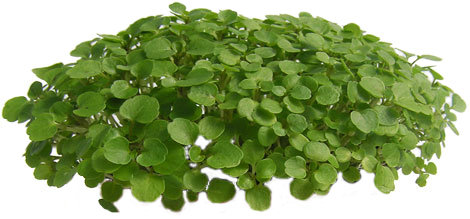

Cress

Lepidium. (From Greek lepis, scale, alluding to the shape of the fruits; name used by Dioscorides.) Cruciferae. Around 150 species of annual, biennial and perennial herbs. Leaves pinnatifid to simple, hairy or glabrous. Inflorescence small, racemose; sepals 4; petals 4, sometimes absent; stamens 6, 4 or 2. Fruit a silicle, dehiscent, compressed, winged or wingless; seeds 2, mucilaginous when wet. Cosmopolitan. CultivationFor a salad garnish, press seed thickly and evenly on to the surface of shallow trays of a friable propagating medium, or on to thoroughly moistened kitchen paper or flannel in a shallow dish (the latter method makes cutting easier). Maintain a temperature of about 10ºC, germinate without light, and keep moist until harvest in 10-14 days. The companion mustard should be sown 3-4 days later, as it germinates more quickly. As a salad green, sow in early spring, as soon as the soil is workable, in shallow drills 30cm apart, with successional sowings at 2-3 week intervals. Soil must be fertile and moisture-retentive and the site sunny to ensure rapid growth, which yields the best harvest if the first cut is not too hard. Summer sowings may rapidly run to seed, but sowings may be made from early autumn onwards for winter salads, with cloche protection in regions where temperatures drop below -5ºC. Seedling cress is extremely susceptible to damping off, and provides a convenient demonstration of the disease. The disease quickly develops on seed sown thickly on unsterilised soil, watered plentifully and covered with glass to maintain high humidity. Lepidium sativumCOMMON GARDEN CRESS; PEPPER CRESS; PEPPERWORT. Annual, 20-60cm. Stem erect, branching. Basal leaves 1-3 times pinnatifid, soon withering; stem leaves bipinnate to entire higher up stem. Petals 2-3mm white-lilac. Fruit 6 x 5mm, broadly elliptic-ovate or nearly round, bluntly winged; pedicel 2-3mm. Most N temperate regions. ‘Broad Leaved’ (‘Mega’, ‘Broad Leaved French’): slender-stalked, recommended for soups; ‘Curled’: ornamental, leaves finely divided; ‘Greek’: fast growing, for cutting young; ‘Moss Curled’: dwarf, very fast growing, leaves finely cut. Cress has long been used both as a salad ingredient and as a flavouring herb for its popular ‘peppery’ flavour which contrasts well with a wide variety of foods.
|
Home
Grow Nuts
Grow Fruit
Grow Vegetables
Cyberian Index
If you like this website and want one of your own contact
Cyberian All information correct at
time of publication and open to updates as necessary. No part of this website,
or its vectors, may be produced in any shape or form, using any type or design
of medium, system, equipment or otherwise without the prior written consensual
notice of the Cyberian. Any breach of these requirements will result in the
appropriate action. If in doubt, e-mail contact is recommended.
Some components of this website were obtained as open-source software and are
used in the same non-profit manner on this website.